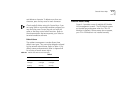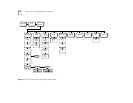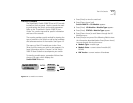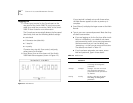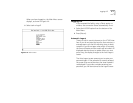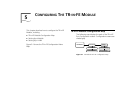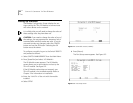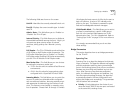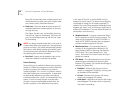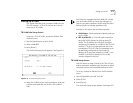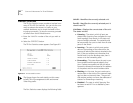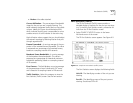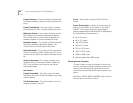
Setting Up a Module 5-3
The following fields are shown on the screen:
Unit ID—Identifies the currently selected Switch unit.
Port ID—Displays the current module type. It should
read TIF.
Admin. State—This field allows you to *Enable* or
*Disable* the TR-in-FE port.
Internal Priority—This field allows you to distribute
the available bandwidth among the ports. *High* pri-
ority ports are given priority access to internal
resources, taking priority over *Normal* priority
ports.
Full Duplex—The TR-in-FE Module works with either
a Full Duplex or Half Duplex mode of operation. The
Full Duplex field allows you to *Enable* or *Disable*
Full Duplex mode. Disabling Full Duplex automatically
puts the TR-in-FE Module in Half Duplex mode.
Max Packet Size—This field allows you two choices
for setting the maximum packet size.
■ 1518—Use this value in traditional Fast Ethernet
environments.
■ 4544—Use this value for larger packets when
configured with a SuperStack II Switch 3000.
Jamming Mode—This field allows you to restrict the
amount of packet loss allowable when configured
with conventional switches. Jamming provides a vari-
able parameter for determining the number of colli-
sions. This feature is most helpful in networks using
lots of repeaters. Choose from J6 through J13 where
J6 indicates the least amount of effort by the port to
back off collisions. A value of J13 indicates more
effort on the port. This feature is reserved for quali-
fied and knowledgeable network managers.
VLAN Enable Mask—This field allows you to restrict
or allow for membership in specific VLAN groups.
Each bit in the two-byte field represents a VLAN
denomination from 1 to 16 in hexadecimal. Refer to
“Setting Up a VLAN” on page 5-5 for more informa-
tion.
It is strongly recommended that you do not alter
these settings.
Bridge Parameters
This section describes how to set bridge parameters
for the TR-in-FE.
Spanning Tree
Spanning Tree is an algorithm designed to eliminate
loops in networks. The algorithm detects and logically
prohibits redundant paths by placing some bridge
ports in the blocking state so that only one route exits
between any two LANs and therefore any two sta-
tions. After Spanning Tree eliminates redundant
paths, the network reconfigures and stabilizes. Any
time the network topology changes, the algorithm
automatically relearns the new configuration and
adjusts the bridge ports accordingly. This guarantees
that all stations are connected.
■ Priority—Priority determines the choice of port
when the Switch 2000 TR has two ports connected
to the same LAN, creating a loop.



